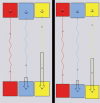Physical principles demonstrate that the biceps femoris muscle relative to the other hamstring muscles exerts the most force: implications for hamstring muscle strain injuries
- PMID: 25506583
- PMCID: PMC4241430
Physical principles demonstrate that the biceps femoris muscle relative to the other hamstring muscles exerts the most force: implications for hamstring muscle strain injuries
Abstract
Of the hamstring muscle group the biceps femoris muscle is the most commonly injured muscle in sports requiring interval sprinting. The reason for this observation is unknown. The objective of this study was to calculate the forces of all three hamstring muscles, relative to each other, during a lengthening contraction to assess for any differences that may help explain the biceps femoris predilection for injury during interval sprinting. To calculate the displacement of each individual hamstring muscle previously performed studies on cadaveric anatomical data and hamstring kinematics during sprinting were used. From these displacement calculations for each individual hamstring muscle physical principles were then used to deduce the proportion of force exerted by each individual hamstring muscle during a lengthening muscle contraction. These deductions demonstrate that the biceps femoris muscle is required to exert proportionally more force in a lengthening muscle contraction relative to the semimembranosus and semitendinosus muscles primarily as a consequence of having to lengthen over a greater distance within the same time frame. It is hypothesized that this property maybe a factor in the known observation of the increased susceptibility of the biceps femoris muscle to injury during repeated sprints where recurrent higher force is required.
Keywords: biceps femoris; force; hamstring; injury; muscle; physics.
Figures

Similar articles
-
Tears of biceps femoris, semimembranosus, and semitendinosus are not equal-a new individual muscle-tendon concept in athletes.Scand J Surg. 2021 Dec;110(4):483-491. doi: 10.1177/1457496920984274. Epub 2021 Feb 21. Scand J Surg. 2021. PMID: 33612019 Free PMC article. Review.
-
Morphological study on the origin of the semitendinosus muscle in the long head of biceps femoris.Scand J Med Sci Sports. 2021 Dec;31(12):2282-2290. doi: 10.1111/sms.14045. Epub 2021 Sep 12. Scand J Med Sci Sports. 2021. PMID: 34472147
-
Hamstring Injury.2023 Aug 8. In: StatPearls [Internet]. Treasure Island (FL): StatPearls Publishing; 2025 Jan–. 2023 Aug 8. In: StatPearls [Internet]. Treasure Island (FL): StatPearls Publishing; 2025 Jan–. PMID: 32644362 Free Books & Documents.
-
Effects of forward trunk lean on hamstring muscle kinematics during sprinting.J Sports Sci. 2015;33(13):1366-75. doi: 10.1080/02640414.2014.990483. Epub 2014 Dec 16. J Sports Sci. 2015. PMID: 25514378
-
Hamstring Injuries Prevention in Soccer: A Narrative Review of Current Literature.Joints. 2020 May 25;7(3):115-126. doi: 10.1055/s-0040-1712113. eCollection 2019 Sep. Joints. 2020. PMID: 34195539 Free PMC article. Review.
Cited by
-
Prediction of hamstring injury in professional soccer players by isokinetic measurements.Muscles Ligaments Tendons J. 2016 May 19;6(1):116-23. doi: 10.11138/mltj/2016.6.1.116. eCollection 2016 Jan-Mar. Muscles Ligaments Tendons J. 2016. PMID: 27331039 Free PMC article.
-
Tears of biceps femoris, semimembranosus, and semitendinosus are not equal-a new individual muscle-tendon concept in athletes.Scand J Surg. 2021 Dec;110(4):483-491. doi: 10.1177/1457496920984274. Epub 2021 Feb 21. Scand J Surg. 2021. PMID: 33612019 Free PMC article. Review.
-
Tensiomyography Allows to Discriminate between Injured and Non-Injured Biceps Femoris Muscle.Biology (Basel). 2022 May 13;11(5):746. doi: 10.3390/biology11050746. Biology (Basel). 2022. PMID: 35625474 Free PMC article.
-
Neuromuscular changes of the aged human hamstrings.J Neurophysiol. 2018 Aug 1;120(2):480-488. doi: 10.1152/jn.00794.2017. Epub 2018 Apr 18. J Neurophysiol. 2018. PMID: 29668388 Free PMC article.
-
Effects of hip flexion angle on surface electromyographic activity of the biceps femoris and semitendinosus during isokinetic knee flexion.Muscles Ligaments Tendons J. 2017 Sep 18;7(2):286-292. doi: 10.11138/mltj/2017.7.2.286. eCollection 2017 Apr-Jun. Muscles Ligaments Tendons J. 2017. PMID: 29264340 Free PMC article.
References
-
- Arnason A, Sigurdsson SB, Gudmundsson A, Holme I, Engebretsen L, Bahr R. Risk Factors for Injuries in Football. Am J Sports Med. 2004;32(1S):5S–16S. - PubMed
-
- Brooks JH, Fuller CW, Kemp SP, Reddin DB. Incidence, Risk and Prevention of Hamsting injury in professional rugby union. Am J Sports Med. 2006;34(8):1297–1306. - PubMed
-
- Askling CM, Tengvar M, Saartok T, Thorstensson A. Acute first-time hamstring strains during high speed running: a longitudinal study using clinical and magnetic resonance imaging findings. Am J Sports Med. 2007;35(2):197–206. - PubMed
-
- Verrall GM, Slavotinek JP, Barnes PG, Fon GT. Diagnostic and Prognostic Value of Clinical Findings in 83 Athletes with Posterior Thigh Injury. Comparison of Clinical Findings with Magnetic Resonance Imaging Documentation of Hamstring Muscle Strain. Am J Sports Med. 2003;31(6):969–973. - PubMed
-
- Connell DA, Schneider-Kolsky ME, Hoving JL, et al. Longitudanal study comparing sonographic and MRI assessment of acute and healing hamstring injuries. AJR. 2004;183(4):975–984. - PubMed
LinkOut - more resources
Full Text Sources
